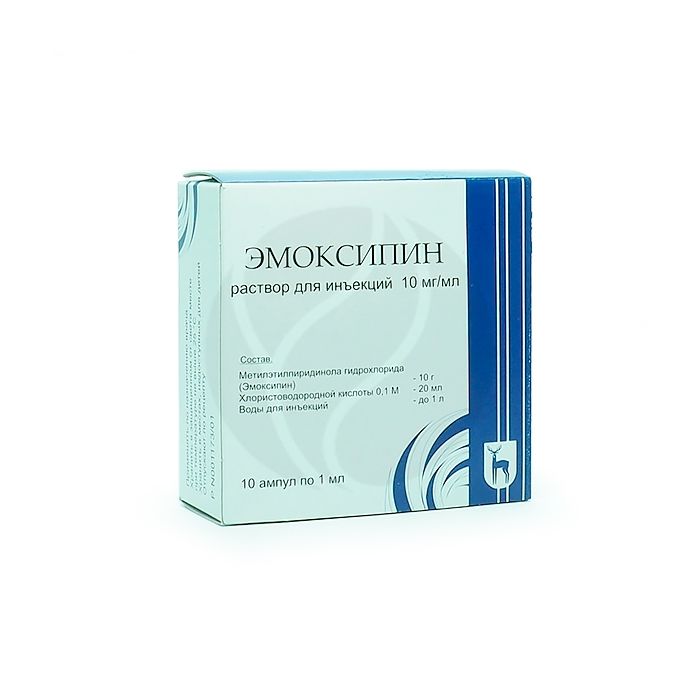Emoxipin solution 1%, 1ml No. 10
Expiration Date: 05/2027
Russian Pharmacy name:
Эмоксипин раствор 1%, 1мл №10
As part of complex therapy:
acute pancreatitis (when performing minimally invasive interventions under ultrasound control and laparoscopy);
hemorrhagic stroke;
ischemic stroke in the basin of the internal carotid artery and in the vertebrobasilar system; transient disorders of cerebral circulation;
chronic cerebral circulation insufficiency;
traumatic brain injury, accompanied by brain contusions;
postoperative period in patients with traumatic brain injury;
operated on for epi-, subdural and intracerebral hematomas, combined with brain contusions;
pre- and postoperative period in patients with arterial aneurysms and arteriovenous malformations of the cerebral vessels;
acute myocardial infarction, prevention of 'reperfusion syndrome';
unstable angina.
Doses, the duration of the course of treatment are determined individually, depending on the indications
Solution for injection 1 ml
methylethylpyridinol hydrochloride (emoxipin) 10 mg
Hypersensitivity; pregnancy; children and adolescents up to 18 years old.
With care Lactation period (according to indications).
pharmachologic effect
Methylethylpyridinol inhibits platelet aggregation, reduces the total coagulation index, and lengthens the blood clotting time. Strengthens the process of fibrinolysis. Reduces blood viscosity, reduces the permeability of the vascular wall. It stabilizes the cell membranes of blood vessels and erythrocytes, increases the resistance of erythrocytes to mechanical injury and hemolysis. It has angioprotective properties. Improves microcirculation. Effectively inhibits free-radical oxidation of lipids of biomembranes, increases the activity of antioxidant enzymes. Stabilizes cytochrome P450, has an antitoxic effect. In extreme situations, accompanied by increased lipid peroxidation and hypoxia, it optimizes bioenergetic processes.
Increases the brain's resistance to hypoxia and ischemia. In case of cerebral circulation disorders (ischemic and hemorrhagic), it helps to correct disorders of the peripheral nervous system, facilitates the restoration of the integrative activity of the brain, and improves mnestic functions.
Expands coronary vessels, reduces ischemic myocardial damage. In myocardial infarction, it limits the size of the necrosis focus, accelerates reparative processes, and helps to normalize myocardial metabolism. Has a beneficial effect on the clinical course of myocardial infarction, reducing the incidence of acute heart failure. Promotes the regulation of the redox system in case of circulatory failure.
Pharmacokinetics
When administered intravenously at a dose of 10 mg / kg T1 / 2 is 18 minutes; total clearance - 0.2 l / min; Vd - 5.2 liters. It quickly penetrates into organs and tissues, where it is deposited and metabolized. Found 5 metabolites of methylethylpyridinol, represented by dealkylated and conjugated products of its transformation. Methylethylpyridinol metabolites are excreted by the kidneys. 2-ethyl-6-methyl-3-hydroxypyridine phosphate is found in significant quantities in the liver.
Side effect
Perhaps: agitation, drowsiness, increased blood pressure, reaction at the injection site (burning sensation along the vein, pain, itching).
Rarely: headache, pain in the region of the heart, in persons with chronic pathology of the digestive system - nausea, discomfort in the epigastric region; in case of a predisposition to allergic reactions, itching and redness of the skin are observed.
Application during pregnancy and lactation
Use during pregnancy is contraindicated. Use with caution during lactation (breastfeeding).
special instructions
During the period of treatment, it is necessary to constantly monitor blood pressure and blood clotting.
Drug interactions
?-Tocopherol acetate potentiates the antioxidant effect of methylethylpyridinol.
Methylethylpyridinol is not recommended to be mixed with other injectables in the same syringe

